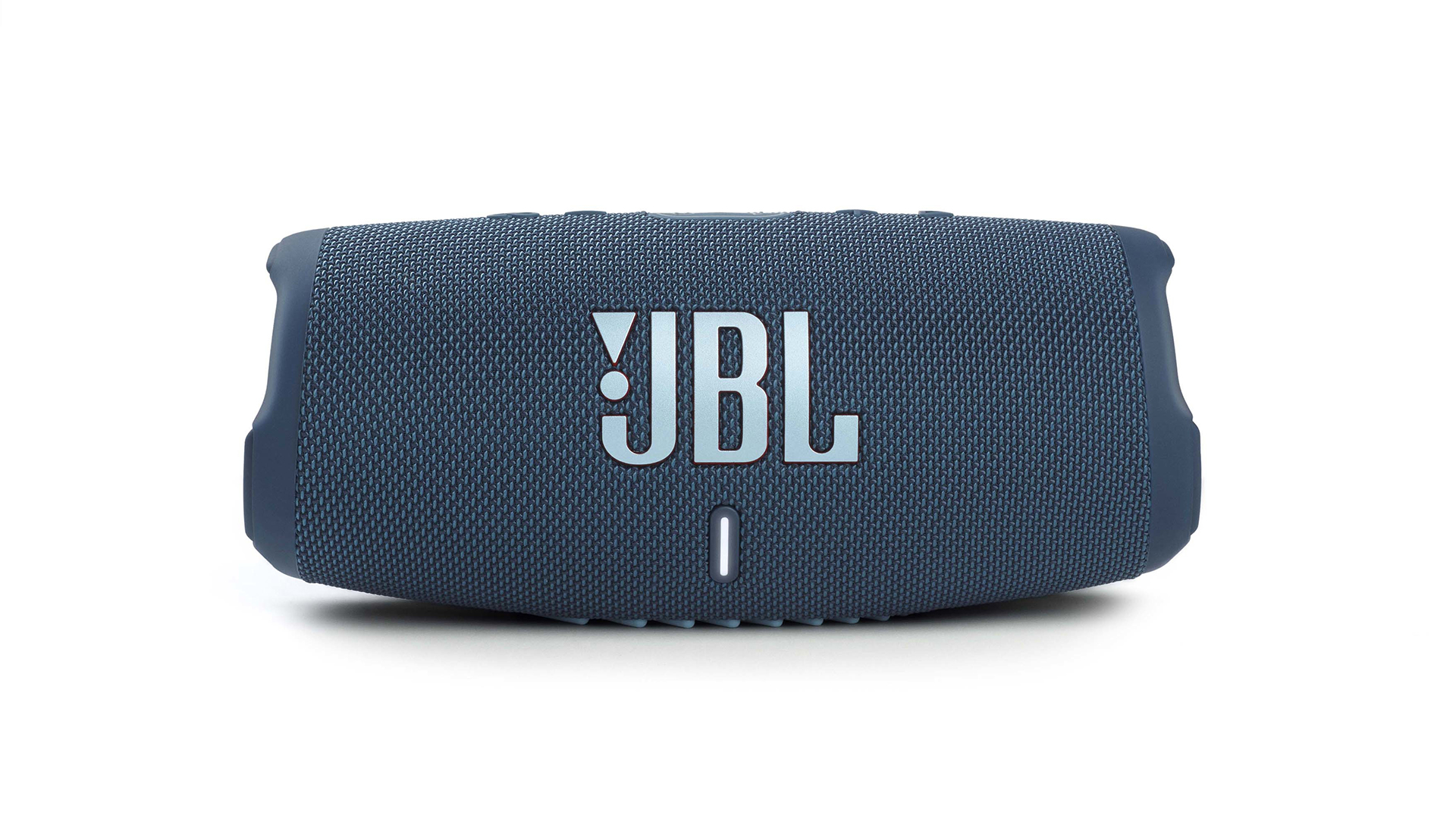When it comes to rugged, portable, no-nonsense Bluetooth speakers, some product lines have consistently impressed us under review. JBL’s Charge is as good an example as any, and so the fact it’s now entering its fifth generation is big news. Anyone looking for substantial on-the-go sound from something roughly the weight and size of a bottle of wine should take note.
The new JBL Charge 5 is, the US audio specialist claims, even more durable and better sounding than the four Charges before it. Its predecessor carried an IPX7 rating, meaning it could handle being submerged in water to a depth of 1.5m, but the IP67-rated Charge 5 builds on that durability by also being fully dustproof.
The iconic aesthetic, available in eight different finishes including our review sample’s navy blue, has been tweaked to introduce a bolder JBL logo and an extra dollop of rubberised reinforcements, too. So, is the Charge just as recommendable as ever in its latest guise?
Build and features
Sitting our Charge 5 sample next to its older sibling, the Charge 4, we play a quick game of spot the difference. The logo is now bigger but looks classier and less like a badge than the branding on its predecessor, with simple metallic accents around the letters rather than a block frame.
The rubberised underbody now comprises pleasing diagonal lines for traction when you set it down, as first seen on the Go 3, rather than a block of opaque rubber.
Gone is the 3.5mm port for wired listening, and the new USB-C charging port is uncovered this time. Under a smaller rubber cap, you still get the useful USB-A port for using the Charge 5 to charge your devices.
JBL Charge 5 tech specs
Finishes x8
Battery life 20 hours
Bluetooth version 5.1
Dimensions (hwd) 22 x 9.6 x 9.4cm
Weight 960g
The ends of the Charge 5’s trademark barrel-like bodywork boast a slightly more robust rubberised reinforcement, while the speaker itself is a whole 1mm taller, 2mm deeper, 3mm wider and 5g heavier than its older brother – although there’s little in that to the naked eye.
Under the hood, however, are plenty of improvements. The 52 x 90mm bass driver is a couple of millimetres wider than before, and there’s a new 20mm tweeter. These units both have dedicated power amplification – 30W for the woofer and 10W for the highs. There is also Bluetooth 5.1 rather than 4.2, but the same 7500mAh battery offers the same 20 hours of playback from a single charge.
The Charge 5 now features a JBL PartyBoost button on the control panel on top of the speaker, too, where the Connect+ button sits on the Charge 4. JBL’s updated daisy-chaining tech means you can beef up your portable sound by linking the Charge 5 with up to 100 other PartyBoost enabled JBL Bluetooth offerings, although that is currently limited to the Boombox 2, Flip 5 and Pulse 4. What you can’t do is link the Charge 5 to the older Charge 4, or any older Connect+ enabled JBL speakers for that matter.
There is support for the Charge 5 on the JBL Portable app, formerly called JBL Connect. It’s good for firmware updates and to deploy PartyBoost from your phone, where other app-supported JBL speakers (including the Flip 5) will appear ready to link. With another Charge 5, you can create a stereo pair by toggling across from “Party” (mono sound) to Stereo when hitting the PartyBoost button, but the app is otherwise basic and doesn’t offer anything by way of EQ optimisation.
Leaving the app, we press the PartyBoost button on the Charge 5, then on our Flip 5, and sound dutifully comes from both, clearly and with no notable lag. It’s a neat feature, although some existing JBL owners may be irked by PartyBoost’s inability to play nicely with the older Connect+ tech.
Sound
We cue up Chamillionaire’s Ridin’ on Tidal and the Charge 5’s extra ounce of prowess over the Charge 4 reveals itself. It’s a fairly minor upgrade, but the hip-hop riff intro is marginally more impactful – the leading edges of notes through the low end are crisper, resulting in a more agile performance. Vocals are also more energised and feel well-placed in what is an expansive mix for a portable speaker of this size.
Erykah Badu’s voice in Tyrone is emotive and as much celebrated through the treble frequencies as through her juicy lower registers. The walking bass guitar that underpins the track feels three-dimensional and is just one of several instruments held in check, alongside whoops from the crowd and occasional drum fills within a cohesive mix.
Bowed strings in British Sea Power’s melancholy soundscape, Tiger King, are detailed and accurate around the track’s sporadic cymbals and drum crashes, proving the Charge 5 is capable of delicacy and nuance as well as oomph and bass clout.
Any brightness in the Charge 5’s new tweeter melts away once the speaker is run in, leaving only cleaner, clearer treble frequencies. Prince’s vocal in Sometimes It Snows In April veers between his trademark head and chest voices and both are equally as impactful through the Charge 5, alongside the pared-back keys and guitar. Female backing vocals in the later choruses are as present and as ethereal as Prince intended.
Verdict
The Charge 5 is currently as good a sound as you can get in a portable Bluetooth speaker design for under £200 ($200, AU$300). It boasts marginal improvements, both sonically and aesthetically, over its predecessor, the five-star Charge 4. One day JBL may produce a Charge that can be outdone by a new and plucky rival, but rest assured, that has not happened yet with the rather splendid Charge 5.
SCORES
- Sound 5
- Features 4
- Build 5
MORE:
Read our guide to the best Bluetooth speakers
Read our JBL Flip 5 review
Read our Bang & Olufsen Beosound A1 (2nd gen) review
